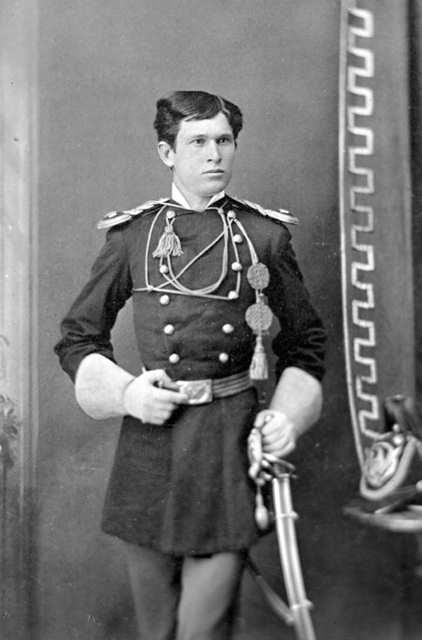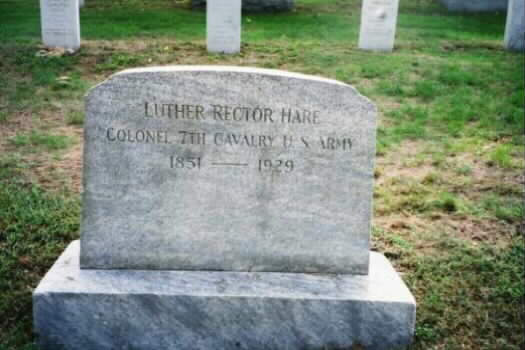Luther Rector Hare was on duty with the Detachment of Indian Scouts under Lieutenant Varnum in the Reno Battalion during the Battle of the Little Big Horn.
Born August 24, 1851 at Greencastle, Indiana, he was the son of Silas and Elizabeth Rector Hare. He entered the United States Military Academy at West Point on September 1, 1870 and graduated on June 17, 1874, as the 2533rd graduate, ranking 25th in his class of 41 graduates.
Appointed Second Lieutenant, 7th Cavalry, on June 17, 1874, and served in the garrison at Colfax, Louisiana, until 1876. Engaged in the Sioux Expedition from May 17 to September 26, 1876, and participated in the Little Big Horn River fight on June 25-26, 1876. After the valley fight on June 25, he joined Company K and engaged in the hilltop fight.
Promoted to First Lieutenant to date from Jun 25, 1876, and transferred to Company I to occupy the vacancy created by the death of Lieutenant James Porter. Engaged in the campaign against Chief Joseph in 1877. Continued to serve on frontier duty and was promoted to Captain on December 29, 1890. As a result of a vacancy created after the fight against Big Foot’s band of Sioux at Wounded Knee Creek, SD May 14, 1898, he was promoted to Lieutenant Colonel, 1st Texas Volunteer Cavalry and June 14 of same year received promoted to Colonel of the regiment. Honorably mustered out of volunteer service in November 1898.
On July 5, 1899, he received appointment as Colonel, 33rd US Volunteer Infantry and took the regiment to the Philippines. He fought there in the battles at San Fabian, Mangatani Bridge, San Jacinto and San Quentin. Appointed Brigadier General, US Volunteers, on June 1, 1900. Discharged from volunteer service Jun 20, 1901.
On February 2, 1901, he was promoted to Major, 12th Cavalry, and on July 16, 1903 was retired for disability. From October 10, 1903 to June 30, 1905, he was on active duty as Inspector General of Militia. From May 29, 1908 to January 15, 1911, he was Professor of Military Science at the University of Texas at Austin, when he again retired. He was promoted to Lieutenant Colonel, Retired, on July 9, 1916, and was appointed Commander of the Student Army Training Corps at Simmons College from January 23, 1918 to February 15, 1919, when he relieved from active duty for the final time.
He died at the age of 78 at Walter Reed Hospital on December 22, 1929, and was interred in the National Cemetery at Arlington, VA. Besides his brother, Judge Silas Hare of Sherman, Texas, he was survived by his 3 daughters, Mrs. Camilla Lippincott, Mrs. Charles Field Mason and the Vicomtesse de Beughem of Brussels, Belgium.
Luther Rector Hare, military officer, son of Octavia Elizabeth (Rector) and Silas Hare, was born at Noblesville, Indiana, on August 24, 1851. In 1853 the Hares moved to Belton, Texas, where Luther began a long and adventurous life on the western frontier. After a seven-year residency (1858-65) at Mesilla, New Mexico, the family returned to Texas and settled in Sherman. There, after finishing school, Hare worked as a printer and typesetter in the offices of the Sherman Courier. In 1870 he secured an appointment to the United States Military Academy through the efforts of John C. Conner, the first Democratic congressman from Texas after the Civil War.
Hare graduated from West Point on June 17, 1874. He accepted an appointment as Second Lieutenant in the Seventh United States Cavalry and served first in Louisiana in the Reconstruction forces. In 1876 he fought with the Seventh Cavalry in the battle of the Little Bighorn, where he was a scout in Major Marcus Reno’s battalion. Hare was commended for his bravery and was promoted to First Lieutenant on June 25, the day of the engagement. During the 1877 Nez Percé campaign Hare fought under Colonel Samuel Sturgis in the battle of Canyon Creek, Montana, where he was once again commended for gallantry. After that battle he continued in service on the Dakota frontier, where he took part in the Sioux Ghost Dance War, and in Arizona Territory on scouting expeditions against the last of the renegade Apaches. During his twenty-four years with the Seventh Cavalry he achieved the rank of Captain.
In 1898, with the outbreak of war in Cuba, Hare was granted a leave of absence to accept an appointment from the state of Texas as Lieutenant Colonel, First Regiment, Texas Volunteer Cavalry. Though he was promoted to full Colonel on June 2, Hare did not see action in Cuba due to the armistice signed in early August.
In February of the following year war broke out in the Philippines, and Hare was called upon to organize the Thirty-third Infantry regiment from Texas. Hare and the Thirty-third landed in Lingayen Gulf on November 7, 1899. Together with other units under General Lloyd Wheaton, the Texans fought at San Fabián, San Jacinto, Tagnadin Pass, and San José. Hare organized and led the Gillmore rescue party, for which he received worldwide recognition. He was awarded two Silver Star citations for his gallantry, and left the Philippines in early 1901 with the rank of brigadier general of volunteers.
He returned to Texas in 1901 with the United States Cavalry as commander of the third squadron of the Twelfth Regiment at Fort Sam Houston. He retired from active duty, with over thirty years service, on July 16, 1903. He subsequently accepted duty with the Texas National Guard and served at Austin as inspector and instructor of militia. He was given added duty as military advisor to Governor T. M. Campbell, a position he held until January 1911. In 1918 Hare was made commandant of the first ROTC at the University of Texas and was appointed professor of military science and tactics. After that service, he accepted the post of commandant, Student Army Training Corps, Simmons College (now Hardin-Simmons University), a position he held until February 1919, when he retired for the last time and returned to his home in Sherman.
Hare married Augusta Virginia Hancock, daughter of a prominent St. Paul military family, on June 21, 1878. His wife was the daughter of John Hancock, Colonel, United StatesArmy. They had three children. Colonel Hare died of throat cancer at Walter Reed Army Hospital in Washington on December 22, 1929. He is buried in Arlington National Cemetery.
NOTE: His son-in-law and daughter, Charles Field Mason, Brigadier General, United States Army, and Mary Eula Hare Mason, are also buried in Arlington National Cemetery.
MASON-HARE
WASHINGTON, March 4, 1903 – Miss Mary Eula Hare, daughter of Colonel Luther R. Hare, United States Army,of Fort Sam Houston, Texas, and Major Charles F. Mason, United States Army of the same post, were married this evening at the residenceof the bride’s grandparents, Colonel and Mrs. John Hancock. No cards of invitation were issued for theceremony, which was attended by only a small family party.
BIBLIOGRAPHY: George W. Cullum, Biographical Register of the Officers and Graduates of the U.S. Military Academy at West Point, New York (8 vols., New York [etc.]: D. Van Nostrand [etc.], 1868-1940). William S. Speer and John H. Brown, eds., Encyclopedia of the New West (Marshall, Texas: United States Biographical Publishing, 1881; rpt., Easley, South Carolina: Southern Historical Press, 1978). Ray Meketa, Luther Rector Hare, A Texan with Custer (Mattituck, New York: Carroll, 1983). Sherman Daily Democrat.
HARE, LUTHER R
LT COL USA RETD
VETERAN SERVICE DATES: Unknown
DATE OF DEATH: 12/22/1929
DATE OF INTERMENT: 12/26/1929
BURIED AT: SECTION S SITE LOT-3933
ARLINGTON NATIONAL CEMETERY
Courtesy of the National Archives
Michael Robert Patterson was born in Arlington and is the son of a former officer of the US Army. So it was no wonder that sooner or later his interests drew him to American history and especially to American military history. Many of his articles can be found on renowned portals like the New York Times, Washingtonpost or Wikipedia.
Reviewed by: Michael Howard


